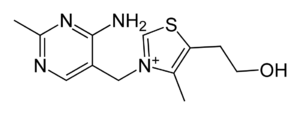Wernicke-Korsakoff syndrome
| Wernicke–Korsakoff syndrome | |
|---|---|
| Synonym | Korsakoff's psychosis, alcoholic encephalopathy |
 |
|
| Thiamine | |
| Classification and external resources | |
| Specialty | neurology |
| ICD-10 | E51.2, F10.6 |
| ICD-9-CM | 294.0 |
| OMIM | 277730 |
| DiseasesDB | 14107 |
| MedlinePlus | 000771 |
| eMedicine | med/2405 |
| Patient UK | Wernicke–Korsakoff syndrome |
| MeSH | D020915 |
Wernicke–Korsakoff syndrome (WKS) is the combined presence of Wernicke's encephalopathy (WE) and Korsakoff's syndrome. Due to the close relationship between these two disorders, people with both are usually diagnosed with WKS, as a single syndrome.
The cause of the disorder is thiamine (vitamin B1) deficiency, which can cause a range of disorders including beriberi, Wernicke's encephalopathy, and Korsakoff's psychosis. These disorders may manifest together or separately. WKS is usually secondary to alcohol abuse. It mainly causes vision changes, ataxia and impaired memory.
Wernicke's encephalopathy and WKS is most commonly seen in people who are alcoholic, and only 20% of cases are identified before death. This failure in diagnosis of WE and thus treatment of the disease leads to death in approximately 20% of cases, while 75% are left with permanent brain damage associated with WKS. Of those affected, 25% require long-term institutionalization in order to receive effective care.
The syndrome is a combined manifestation of two namesake disorders, Wernicke's encephalopathy and Korsakoff's psychosis. It involves an acute Wernicke-encephalopathy phase, followed by the development of a chronic Korsakoff's syndrome phase.
WE is characterized by the presence of a triad of symptoms;
This triad of symptoms results from a deficiency in vitamin B1 which is an essential coenzyme. The aforementioned changes in mental state occur in approximately 82% of patients symptoms of which range from confusion, apathy, inability to concentrate, and a decrease in awareness of the immediate situation they are in. If left untreated, WE can lead to coma or death. In about 29% of patients, ocular disturbances consist of nystagmus and paralysis of the lateral rectus muscles or other muscles in the eye. A smaller percentage of patients experience decrease in reaction time of the pupils to light stimuli and swelling of the optic disc which may be accompanied by retinal hemorrhage. Finally, the symptoms involving stance and gait occur in about 23% of patients and result from dysfunction in the cerebellum and vestibular system. Other symptoms that have been present in cases of WE are stupor, low blood pressure (hypotension), elevated heart rate (tachycardia), as well as hypothermia, epileptic seizures and a progressive loss of hearing.
...
Wikipedia
